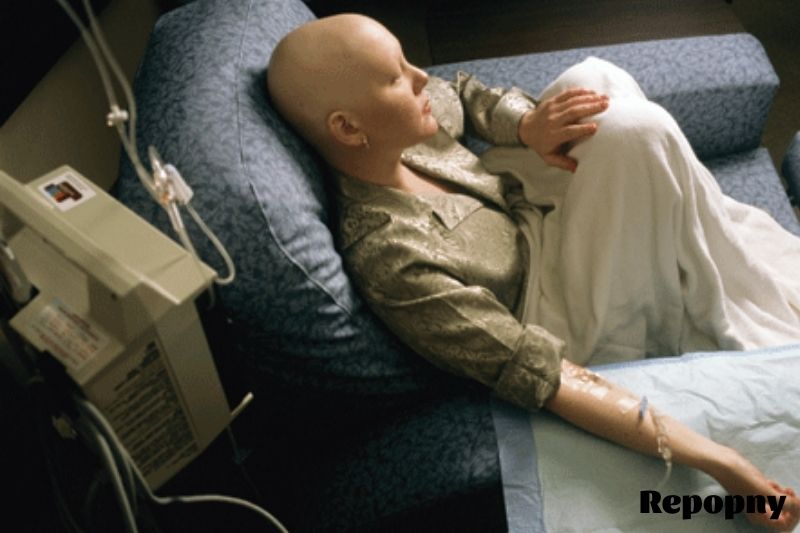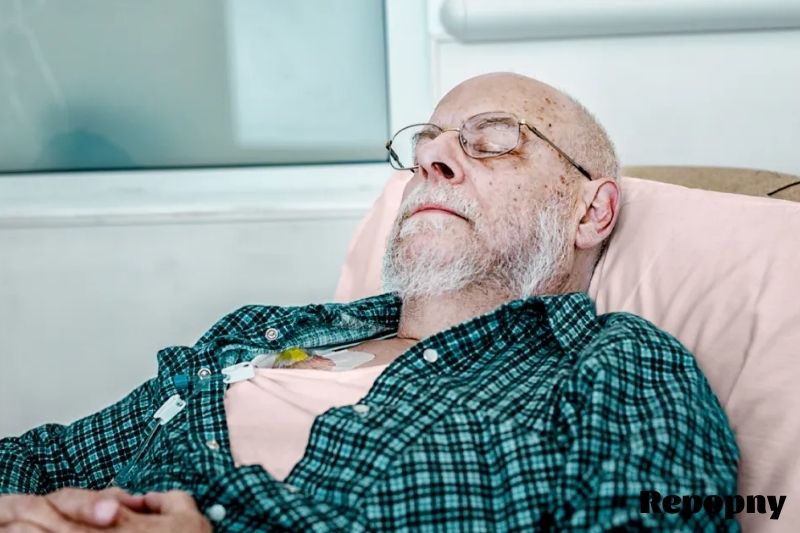If you or a loved one has cancer, you may be wondering how to sleep with a chemo port. A chemo port is a small, round device placed under the skin on the chest. It is used to give chemotherapy treatments.
The port has a tube that goes to the heart, so it is essential to be careful when sleeping with a chemo port. Repopny will provide some tips on how to sleep with a chemo port.
Contents
- 1 What Exactly Is A Port?
- 2 What Effect Do Chemo Ports Have On Sleep?
- 3 Sleeping With A Chemo Port: Some Pointers
- 4 How To Sleep On The Side Of The Body
- 5 What To Do About Chemo Port Discomfort
- 6 What To Do If You Have A Chemo Port And What Not To Do?
- 7 When Should You See A Doctor?
- 8 When Is It Necessary To Use A Chemo Port?
- 9 Is It Possible That The Port Will Fall Out If I Roll Over?
- 10 What Can I Do To Make Sleeping With A Port More Comfortable?
- 11 Conclusion
What Exactly Is A Port?
A surgically implanted port is a device that provides intravenous (IV) access to chemotherapy, medicines, transfusions, and blood draws. It consists of a tiny reservoir and a catheter that allows you to access more prominent veins. Patients who require long-term IV access, such as during chemotherapy, may have a port implanted.
Many people wonder whether or not having a port would affect their sleep once it has been inserted. It’s critical to build new habits that you can incorporate into your nighttime routine and lifestyle to alleviate pain and ensure proper sleep to aid in the healing process.
What Effect Do Chemo Ports Have On Sleep?
Chemo ports, also known as portacaths, are medical devices implanted beneath the skin by doctors. They can last anywhere from a few weeks to a couple of years. You can trust them. As a result, the person will be able to carry out all of their normal activities, including sleeping, while wearing the chemo port.
People may suffer some pain, itching, or discomfort when doctors first place a chemo port, which can disrupt sleep momentarily. People who sleep on their stomachs may have some issues as well. Lying on one’s stomach can undue strain on the port, aggravating the situation.
Sleeping with a chemo port should be simpler once the skin heals and a person has had time to acclimate to a new sleeping position.
It’s worth mentioning that, aside from having a chemo port, persons with cancer can have sleep problems for various causes. According to an older study from 2012, 30–87 percent of cancer patients have sleep disturbances. These pauses could be caused by a variety of factors, including:
- As a side effect of the treatment, sleep issues develop.
- Chemotherapy is generating other problems that are making it difficult to sleep.
- the mental health implications of cancer and cancer treatment
- To manage exhaustion, change your usual pattern, such as sleeping in late or taking frequent naps.
Sleeping With A Chemo Port: Some Pointers
While the skin surrounding their chemo port heals, people can take numerous things to make sleeping more comfortable.
Change sleep position
“Sleeping on your back is the ideal position. “This position avoids pressure from building up on the port, which could cause pain,” Lyon explained. This may necessitate a modification in your usual sleeping position.
You might also discover that sleeping on your side is more pleasant. If this is the case, it is preferable to sleep on the opposite side of the port. Sleep on your left side if your port is on the right side of your chest, or vice versa.
At least at first, you should avoid sleeping on your stomach because you can have soreness at the port. Avoid sleeping with your arm up on the side of your body where the port is located since this may cause the port to pull. Avoid twisting or pulling actions with the port on the side of your body.
“As the port insertion site heals following surgery, the pain will improve,” Lyon said.
Wear comfortable clothing
It’s preferable to sleep in loose-fitting, light, and soft clothing that won’t scrape or irritate your skin. Pajamas with buttons, poppers, or other similar elements down the middle, for example, may dig into the chemo port.
If a person is experiencing heat or night sweats due to their chemotherapy, wearing breathable pajamas made of natural fibers may assist.
Consider purchasing a new mattress
If at all possible, a new mattress should be considered. A sagging or uncomfortable mattress may induce someone to sleep in the middle of the bed or toss and turn to become comfortable. If your mattress isn’t supportive enough, sleeping on your back can be difficult.
Replace your pillows with more supportive ones
Pillows should also provide the appropriate level of support for persons who have a chemo port. Tossing and turning, which can irritate the port, can be reduced with a comfy pillow.
Sleeping pillows should provide adequate support for the head, neck, and shoulders. More giant pillows for body support may also be beneficial, particularly if someone is transitioning to a new sleep position or moving around while sleeping.
If you have gallbladder surgery, read this article, maybe it helps: How To Sleep After Gallbladder Surgery?
How To Sleep On The Side Of The Body
Although sleeping on one’s back is preferred for persons with chemo ports, side sleeping is an option. On the other hand, side sleepers will need to think about a few things after their chemo port is installed.
The skin will be sensitive and may hurt immediately after the surgery. Any unnecessary contact or pressure should be avoided. As a result, until the area heals, a person must sleep on their back.
Applying pressure to the area after it has healed is not a good idea since it might cause irritation or discomfort. People can try the following to sleep on their side without putting pressure on their chest:
- Body pillows support their bodies and keep them from rolling onto their backs.
- Between the knees with a cushion
- To avoid sleeping on the side of the body with the chemo port, place giant pillows on one side of the bed.
What To Do About Chemo Port Discomfort
It is common to feel discomfort after a doctor inserts a chemo port. Swelling, inflammation, and discomfort are all likely side effects. Bruising is also possible, and it takes longer to heal.
During the first 1–2 days after the surgery, avoid wearing any clothing or anything that puts pressure or friction on the chest. Here are several examples:
- clothing that is too tight, such as bras
- Straps or cross-body bags
- suspenders
People should also refrain from lifting heavy things or engaging in rigorous exercise until the incision has healed, taking around one week. When it’s safe to resume exercising, see your doctor.
People can use pillows or padding to cushion tight garments and inevitable restraints, such as seatbelts.
What To Do If You Have A Chemo Port And What Not To Do?
Although a chemo port is a low-maintenance device, there are a few things to remember once it’s in place.
Do’s
- If the port hasn’t been used to administer medication or draw blood for lab tests, have the lines washed out once a month. Cleaning the lines should be done at the end of each session, but if you are gone for weeks or months, you should arrange a cleaning to avoid infection or other complications.
- Contact your doctor’s office if you detect any changes around the port site, such as pain or redness. It could be an indication of infection or inflamed tissue.
- Depending on your health and energy levels, you can exercise, work, play, and engage in most of your typical activities a few days after the port is placed.
- The port is unaffected by showering or swimming. If you have any concerns about a particular activity, contact your doctor’s office and speak with a nurse or a physician.
Don’ts
- As long as the port is in place, avoid contact sports like football or rugby.
- For the first few days after the port has been implanted, avoid doing any hard lifting.
When Should You See A Doctor?
For those who have chemo ports, some slight discomfort is expected. It is critical, however, to seek medical attention as soon as possible if a person develops:
- a high temperature
- Long after the treatment, there may be edema or discoloration.
- excruciating agony, especially when there isn’t any apparent reason
- Around the port site, there is a lot of fluid or pus.
- chest discomfort
- Breathing problems
- After exerting pressure for 15 minutes, there is still bleeding around the port.
- Because chemotherapy affects the immune system, it’s critical to respond swiftly if signs of infection appear.
Chemo ports must also be cleaned regularly. Before giving the next round of medication, a healthcare provider should flush out port lines throughout each chemotherapy session. To avoid difficulties, a person should request chemo port cleaning at a local hospital if it has been more than a month since their previous treatment.
When Is It Necessary To Use A Chemo Port?
Chemotherapy is a standard therapeutic option for a variety of cancers. Chemotherapy could last several weeks or months, or even longer. This is dependent on how the disease progresses and how your body responds to treatment.
If your doctor thinks you’ll need more time to finish chemotherapy, see if an implanted chemo port is good. If the number of chemo sessions is limited, IV administration may be preferable.
Is It Possible That The Port Will Fall Out If I Roll Over?
No. Many individuals are concerned that the port may fall out, but Lyon claims that the port is securely implanted beneath the skin in your chest and will not fall out if you roll over or move around in bed. However, if you rub or strain on the port site while healing, the incision may open and bleed.
Infection is a possibility, so tell your doctor if the wound is red, oozing, swollen, or heated.
What Can I Do To Make Sleeping With A Port More Comfortable?
Pillows can be placed on your sides to provide support and prevent you from moving about while sleeping. Wear loose, comfortable pajamas with no buttons that could irritate the port.
Consider replacing your mattress if it is old and saggy. “Supportive mattresses may help you sleep better and move around less,” Lyon said.
Conclusion
While the benefits of keeping a chemo port under the skin while you sleep are great, it is still essential to be careful with your port. Avoid sleeping on your back.
This is because chemo often makes you feel tired and sleepy. You will not be able to respond quickly enough to an emergency if you are asleep when one happens.




